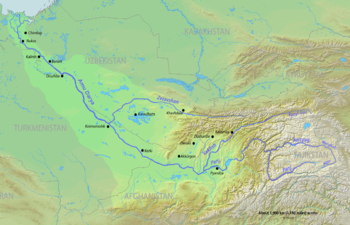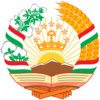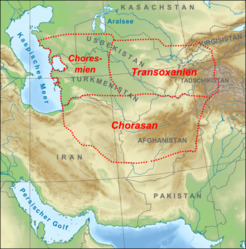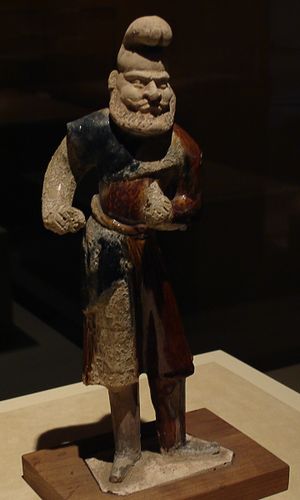بلاد ما وراء النهر

بلاد ماوراء النهر (Transoxiana ويـُقصد بالنهر جيحون) هي الإسم القديم لجزء من آسيا الوسطى، تشمل أراضيها جمهورية أوزبكستان وطاجيكستان والجزء الجنوب الغربي من كازاخستان وجنوب قيرغيزستان. وجغرافياً هي المنطقة بين نهري جيحون في الجنوب وسيحون في الشمال.[1]
It is known in Arabic as Mā Warāʾ an-Nahr (العربية: ما وراء النهر, [ˈmaː waˈraːʔ anˈnahr] – '[what is] beyond the [Jayhūn] river') and in Persian also as Farā-rūd (فارسية: فرارود, [fæɾɒːˈɾuːd̪] – 'beyond the [Amu] river'), Varā-rūd (فارسية: وَرارود), Faro-rüd (بالطاجيكية: Фарорӯд) and Varaz-rüd (بالطاجيكية: Варазрӯд). The Arabic term passed into Persian literary usage and stayed on until post-Mongol times.[2] The area had been known to the ancient Iranians as Turan, a term used in the Persian national epic Shahnameh,[3] and to the Romans as Transoxiana (Land beyond the Oxus).
The region was one of the satrapies (provinces) of the Achaemenid dynasty of Persia under the name Sogdiana. It was defined within the classical world of Iran to distinguish it from Iran proper, especially its northeastern province of Khorasan[4]—a term originating with the Sasanians[5]—although early Arab historians and geographers tended to subsume the region within the loosely defined term "Khorasan" designating a much larger territory.[6][7] The territories of Khwarazm, Sogdiana, Chaghaniyan, and Khuttal were located in the southern part of Transoxiana; Chach, Osrushana, and Farghana were located in the northern part.[8]
. . . . . . . . . . . . . . . . . . . . . . . . . . . . . . . . . . . . . . . . . . . . . . . . . . . . . . . . . . . . . . . . . . . . . . . . . . . . . . . . . . . . . . . . . . . . . . . . . . . . . . . . . . . . . . . . . . . . . . . . . . . . . . . . . . . . . . . . . . . . . . . . . . . . . . . . . . . . . . . . . . . . . . . .
التاريخ
وقد عرف الأوروبيون هذه المنطقة حتى بداية القرن العشرين باسم ترانسأوكسانيا[9]؛ وهي ترجمة لاتينية للاسم اليوناني القديم الذي يعني "ما وراء نهر الأوكسوس". أطلق العرب المسلمون على تلك المنطقة اسم "بلاد ما وراء النهر" عندما فتحوا تلك المنطقة في القرن الهجري الأول إشارة إلى النهرين العظيمين الذين يحدانها شرقا وغربا: نهر سيحون Syr Daria (2212 كم) وجيحون Amur Daria (1415 كم)؛ وهي ترجمة حرفية للتسمية الفارسية القديمة "فرارود".
جزء من المنطقة فتحه قتيبة بن مسلم بين 706 و 715 واحتفظ به، بشكل فضفاض، الأمويون من 715 حتى 738. الفتح الأموي دعمه نصر بن سيار بين 738 و 740، وتواصل بعهد الأمويين حتى 750، حين تابعه العباسيون. أسرة تانگ سيطرت على الجزء الشرقي من المنطقة حتى نفس الوقت تقريباً، حين نشبت حرب أهلية هي تمرد آن لوشان.
جنگيز خان، مؤسس الامبراطورية المنغولية، غزا بلاد ما وراء النهر في 1219 أثناء فتحه خوارزم. وقبل وفاته في 1227، خصص أراضي غرب آسيا الوسطى لإبنه الثاني چقطاي، وأصبحت تلك المنطقة تُعرف بإسم خانية چقطاي. وفي 1369، أصبح تيمورلنك، من قبيلة برلاس/ الحاكم الفعلي وجعل من سمرقند عاصمة امبراطوريته المستقبلية. وقد ازدهرت بلاد ما وراء النهر في منتصف القرن الرابع عشر.[10]
أهم المدن
جزء من سلسلة عن |
|---|
| تاريخ طاجيكستان |
 |
| خط زمني |
سمرقند – بخارى – كاشان - فرغانة – طشقند – خوارزم – مرو – ترمذ.[11] وهي أسماء تدل على أعلام لهم مكانتهم في التاريخ، مثل: الخوارزمي، والفارابي، والبخاري، والترمذي، وابن سينا، والجرجاني، والسجستاني، والبيروني.
الدين
انتشرت بها، سابقاً، الزرادشتية والبوذية والمسيحية النسطورية والمانوية والمزدكية. ويعتبر الإسلام الديانة السائدة في تلك المناطق. ويشكل الأوزبك، الكازاخ والروس الأغلبية العرقية في تلك المناطق.
أشخاص بارزون
انظر أيضاً
المصادر
- ^ "Transoxania (historical region, Asia)". Encyclopedia Britannica (in الإنجليزية). Retrieved 2017-11-10.
- ^ C. Edmund Bosworth, (2002), 'CENTRAL ASIA iv. In the Islamic Period up to the Mongols' Encyclopaedia Iranica (online)
- ^ Sabloff, Paula L.W. (2011). Mapping Mongolia: Situating Mongolia in the World from Geologic Time to the Present. Philadelphia: University of Pennsylvania Museum of Archaeology and Anthropology. p. 62. ISBN 978-1934536186. OCLC 794700604.
- ^ Svat Soucek, A History of Inner Asia, Cambridge University Press, 2000, p.4
- ^ "Khorāsān". britannica.com. Encyclopædia Britannica, Inc. Retrieved 14 November 2018.
- ^ C. Edmund Bosworth, (2002), 'CENTRAL ASIA iv. In the Islamic Period up to the Mongols' Encyclopaedia Iranica "In early Islamic times Persians tended to identify all the lands to the northeast of Khorasan and lying beyond the Oxus with the region of Turan, which in the Šāh-nāma of Ferdowsī is regarded as the land allotted to Ferēdūn’s son Tūr...At the outset, however, those nearby parts of Central Asia with which the Arabs were familiar were often subsumed into the vast and ill-defined province of Khorasan, embracing all lands to the east of Ray, Jebāl, and Fārs." (online)
- ^ C. Edmund Bosworth, (2011), 'MĀ WARĀʾ AL-NAHR' Encyclopaedia Iranica " It was defined by the early Arabic historians and geographers as the lands under Muslim control lying to the north of the middle and upper Oxus or Āmu Daryā, in contrast to Iran proper and its eastern province of Khorasan, sometimes called Mā dun al-nahr (lit. “what lies this side of the river”), although from the perspective of Arab historians writing in distant Iraq, the term “Khorasan” might extend to all lands beyond the Oxus, including Khwarazm and Transoxiana." (online)
- ^ Dickens 2018.
- ^
{{cite web}}: Empty citation (help) - ^ The Timurid Empire
- ^
{{cite web}}: Empty citation (help)


